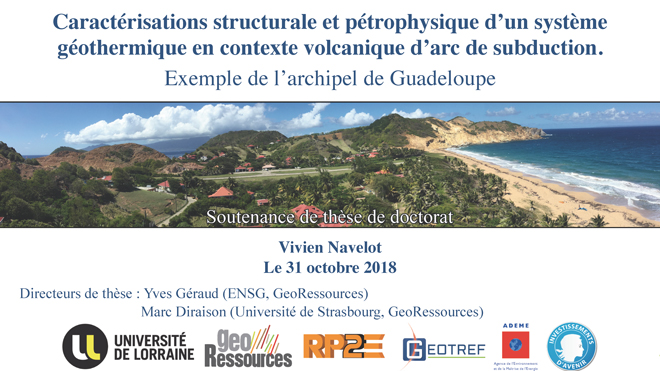
The third GEOTREF PhD has been defended by Viven Navelot at 2 pm, the 31st October 2018, in the Ecole Nationale Supérieure de Géologie de Nancy: Structural and petrophysical characterization of a geothermal system in a volcanic subduction arc context. Example of the Guadeloupe archipelago.
Abstract
Geothermal systems located on active volcanic islands lying above subduction areas are increasingly being prospected and exploited as they represent significant, renewable and accessible energy resources with relatively low operating costs. The Basse-Terre Island in the Guadeloupe archipelago and more precisely the Vieux-Habitants area gathers several indicators allowing to suppose the occurrence of a high-temperature hydrothermal system.
It combines a tremendous heat source marked by active volcanism and a well-developed structural framework providing a major part of the percolation network. Moreover, the reservoir reload is allowed by abundant precipitation. The interpretation of geophysical data acquired for the exploration of the geothermal system requires the analysis of analogues. Several hydrothermal paleo-systems were studied in order to propose a conceptual model of a geothermal system for the Lesser Antilles arc. The studied areas are the oldest parts of the islands of Basse-Terre (Basal Complex) and St. Kitts as well as the central part of Terre-de-Haut (Les Saintes archipelago). Then the model is applied to the area of interest of the GEOTREF program (in the Vieux-Habitants area) where an exclusive research permit was obtained. The ultimate goal is to develop a conceptual model that can be used as a guide for geothermal exploration in active volcanic islands lying above subduction areas.
This study is based on two axes: 1 – a multi-scale study of the brittle deformation from the kilometer-scale to the centimeter-scale and 2 – a petrophysical characterization of the different volcanic formations that can compose the reservoir.
The analysis of fault and fracture indicates that it is not possible to describe their organization with a single mathematical law. Therefore, there is a characteristic scale for each level of observation. Volcano-sedimentary units are far less deformed compared to highly fractured lavas. The brittle deformation in volcano-sedimentary deposits is highly localized in fractured corridors. Intersections of WNW-ESE and NNE-SSW faults control major fluid flow at the kilometer scale. Moreover, the most hydrothermalized rocks are localized in the vicinity of these intersections. Hydrothermal alteration decreases very quickly away from these intersections. At a lower scale major fractures, cooling joints and the deposit surfaces of debris flow and pyroclastic deposits concentrate the fluid flow.
Volcanic rocks are divided into different groups according to their origin (lavas, debris flows and pyroclastic deposits) and the degree of alteration (hydrothermal and weathering). They exhibit strong heterogeneities of petrophysical properties with: 1 – porosities between 1 % and 70 %; 2 – a variation over 8 orders of magnitude for permeability; 3 – P-wave velocities ranging from less than 500 m.s-1 to more than 6000 m.s-1; and 4 – thermal conductivities between 0,45 and 2,1 W.m-1.K-1. Fresh rock types are separated in two distinct groups, on one side lavas and on the other side debris flows and pyroclastic deposits. Hydrothermal alteration produces mineralogical replacements involving a complete reorganization of both the matrix skeleton and the pore network. It is marked by a removal of magnetic signal, an increase of porosity and permeability in lavas and a decrease of these properties in debris flows and pyroclastic deposits. Therefore, hydrothermalized rocks form a group with intermediate reservoir properties between the two groups of fresh rocks.
The reservoir model combines both structural components and lithological heterogeneities that allow an efficient fluid transfer, whereas the matrix properties of primary and secondary origins will control the fluid and heat storage properties.
Keywords: geothermal energy, petrophysics, structural geology, hydrothermal alteration, multi-scale study, conceptual model, fractured reservoir.
